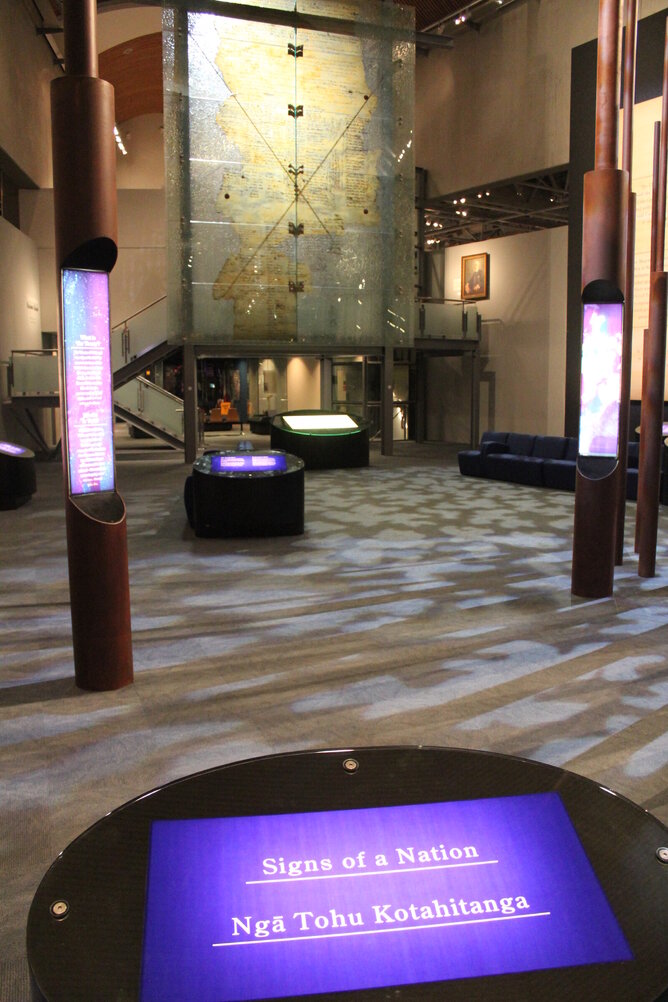Kotahitanga and biculturalism, and the relevance of Te Tiriti o Waitangi in Aotearoa New Zealand
I am hopeful that the following distillation - opinion piece - might provide a useful background to an unsurprisingly puzzling, somewhat paradoxical situation occurring in Aotearoa-New Zealand. For many people in this country (and perhaps many outside!) there is considerable difficulty in comprehending the possibility of kotahitanga (coming together as “one people”, or “unity”), at the same time as being actively engaged in a bi-cultural journey.
Interplays between tino rangatiratanga, kotahitanga, and sovereignty
"Kotahitanga" can be applied in many different contexts – cultural, spiritual or even political. But regardless of context, to really grasp this concept properly much is demanded of the reader since it presumes a clear understanding of the notion of tino rangatiratanga.
There is no “quick and easy” explanation, so a modicum of historical narrative is required to get the full extent of the message across.
To achieve this, we really need to go back to circa 1840 - since the essence of tino rangatiratanga is central to themes contained in The Treaty of Waitangi (Te Tiriti o Waitangi). This relates to the fact that both signatories (i.e. Pākehā and Māori) believed they had sovereignty over Aotearoa/New Zealand. However, there are fundamental differences between the Māori concept of ceding governorship or te Kāwanatanga (governorship of New Zealand) in return for te tino rangatiratanga (chieftainship over lands, dwelling places and other property), as compared to the European concept of “sovereignty”.
Awareness of this situation has come about since, although Te Tiriti is legally just one Treaty, it is in reality two treaties – one, an English version, and another, a Māori version. The way in which the CMS missionary Henry Williams handled the translation of the English word “sovereignty” into a Māori-centric understanding is probably the root source of the considerable and robust debate held by generations since the signing of Te Tiriti by both British officials and about 500 Maori chiefs, the majority of whom signed the Māori version.
This has ultimately led to many current concerns in New Zealand which have substantial racial and legal implications. Many peoples’ understanding just limits itself to an overly simplistic view that Te Tiriti essentially just transferred sovereignty of New Zealand to the British crown. However, aside from it being a good deal more complex than that, there are key significant differences between the two treaties. These differences typically focus on issues relating to governance of the country (which Maori commonly agree they acceded to in exchange for protection as British citizens), as against sovereignty (to which Māori commonly maintain they did not agree to).
Treaty and sovereignty
Understanding these differences are vital to any meaningful discussion especially given the extremely plausible argument that many chiefs would not have signed the treaty in the first place had they had understood that by doing so they were surrendering ‘complete sovereignty’ over their tribal lands. So on the one hand, it can be argued that there may have been a deliberate blurring that amounted to granting Māori only “a limited degree of ‘native sovereignty’ ” that could be easily pulled back if it posed a potential threat to the British. Other less cynical explanations, and this is probably the “Keith Newman camp”, suggest that the Māori version merely utilises reluctantly translated nomenclature, i.e. using the biblical language Māori were most familiar with.
Regardless, in both instances there is consistency that the original intention was, amongst other things, to protect Māori from the onslaught of European settlement (and perhaps to protect Pākehā as well). Whatever the Māori chiefs thought that British rule and Te Tiriti meant, it is hard to imagine that it would not have included a belief that they would continue to occupy and possess their lands and fisheries, and control their own destinies.
Enter the Waitangi Tribunal - facilitating the Crown’s acknowledgement of grievances, formal apology, cultural redress
Thankfully, it is through the Waitangi Tribunal and its legislated process (though not a perfect process), that a significant number of long held grievances relating to breaches of Te Tiriti and subsequent betrayal by Pākehā have been able to be articulated, publically aired, and the opportunity for sites and other matters of cultural significance formally identified. For some, this has facilitated the grieving process and provided at least partial closure. Whilst full compensatory restoration has not been possible, the Crown’s acknowledgement of grievances, formal apology, cultural redress, along with financial and commercial compensation, have gone some way towards recompensing actions and omissions by the Crown which have breached its obligations under Te Tiriti o Waitangi.
It is of great relevance to note that it is the apology that has often provided the greatest restorative affect, serving to rebuild lost relationships between Māori and Pākehā, and / or Māori and the Crown. For others it will be the restoration of matters or sites relating to cultural significance. In all cases the financial redress will no doubt be welcome, albeit considered insufficient by many, and certainly acknowledged by everyone whom is properly informed as being nowhere near true value.
As an academic primarily involved in property economics, and one specialising in rural valuation and investment, this is a matter close to my heart. It is of both professional, personal, and even spiritual interest to me. However, for some European New Zealanders, and more particularly those unable to grasp the concept of “one nation – two peoples”, it unfortunately represents a needless reminder of grievances more correctly belonging to an ugly, historical past for which they are not personally responsible. As such, Te Tiriti and its resulting settlements might represent a bewildering and confusing array of extravagant, expensive measures that are more borne out of needless political correctness, rather than a genuine attempt to “move on” and treat all New Zealanders with a true sense of equality.
Tangata whenua (indigenous people of the land), and the right of Pākehā as Tangata Tiriti (people of the treaty) to co-exist in Aotearoa
For some groups of people, a response by virtue of kotahitanga represents one further step forward in restoration of God’s broken plan for Aotearoa which is clearly embedded within the Godly covenant of Te Tiriti o Waitangi. Godly because historically, it is almost undeniable that the first people of New Zealand clearly thought of Te Tiriti as an un-breachable covenant not only between Māori and Pākehā, but between them and God. Kotahitanga is completely consistent with this as it seeks true unification of God’s people as one, at the same time as recognising that we do that in a bi-cultural context of two people, Māori and Pākehā, coming together as God’s children.
At this juncture it is important to remember that, Te Tiriti serves to protect not only tangata whenua (as the indigenous people of the land), but also Pākehā-Europeans and their right, by invitation, to co-exist in Aotearoa. This is why some have termed Pākehā as being Tangata Tiriti – people of the treaty.
The whole journey of Te Tiriti as a Godly covenant between two peoples is completely and inexorably intertwined with the historical narrative – and that is why it is so important that the full and complete story be exposed. This ties in with an understanding by all people – Pākehā and Māori alike - that true Christian revival in this nation can occur. It is in this way, and perhaps only by this way, that we can all “proceed forward by looking back”. It is utterly naïve to think that we should simply disregard the past and “get on with it”, all joining our hands together and expecting to move forward. That is the language of conquerors without conscience.
The historical spiritual aspect of Aotearoa’s greatest taonga.
E te atua / Runga Rawa (God) has already moved miraculously in this land, with a spiritual movement ultimately exploding like wildfire with the spread of the Gospel te Rongopai in Aotearoa New Zealand. It commenced proper from humble beginnings in 1814 when Samuel Marsden preached at Oihi. The subsequent explosion, some years later, was primarily achieved by God’s Holy Spirit working through Māori amongst Māori – albeit initiated by some very brave Pākehā missionaries who were more or less land locked in what was then, in the 1800’s, a fairly dangerous place to be. Ultimately Aotearoa became a genuinely Christian nation – a nation of not only almost exclusively te Reo speaking (regardless of whether you were Māori or Pākehā), but more importantly almost exclusively followers of Ihu Karaiti (Jesus Christ).
Sadly, that time has gone: but God obviously had a plan. And whilst that plan has broken down, it is one that can be restored, and needs to be restored. But it cannot be done in isolation from Māori. Tangata Whenua were, and still are, the key. They are surely Aotearoa’s greatest taonga. It is not thinking about how we as the body of Christ can get Māori on-board with us; rather, it is about turning our minds as to how we can get on-board with Māori. How can we integrate tikanga and Kaupapa Māori ideals into our whanau? Into our lives?
To some this will be challenging. It may even be what I like to term “God’s upside down thinking”; but then think about that: it is the way God – our God of the improbable - typically works. The last will be first, and the first will be last. The least shall be the greatest, and the greatest shall be the least. This is obviously so important – vital to the prophetic word - and is in fact absolutely crucial for our modern day church family to come to grips with.
Therefore, and following in the spirit and true intent of Te Tiriti o Waitangi, through kotahitanga we now have a wonderful opportunity for reinvigoration of this Godly covenant: Tangata Tiriti re-joining with Tangata Whenua and become one people in Christ – to become what I would like to call Tangata Ihu – the Jesus People of Aotearoa! Two peoples yet one!
Concluding comments
These are just a few thoughts of one brash Aussie, not only trying to be a good kiwi (J), but also one having a whakapapa descended through the people of Te Wairoa ki Tauranga (Ngati Ranginui iwi and hapu Ngati Kahu): a “Pākehā-Māori” - in many ways caught between two worlds but having a heart to heal and restore. But most of all, as a proud member of tangata whenua also having a heart to respond to God’s broken plan, and help in the widespread understanding of what God is doing in this wonderful country my wife Nicole and I now call home.
I would love to hear feedback from anyone who would like to respond to any matter raised herein. It is just one representative view of a really complex situation.
E to matou Matua i te rangi, Kia tapu tou Ingoa , Kia tae mai tou rangatira-tanga. Amine
Our Parent in the spirit world, Sacred is your Name, Bring us Your Chiefly rule. Amen).
Whilst the foregoing represents the personal views, understanding and observations of the author, the following sources have been utilised (extracted, adapted, or simply used as a reference) in formulating such opinion.
Asher, G., Naulls, D., & New Zealand Planning Council. (1987). Maori land (Vol. no. 29.). Wellington [N.Z.]: New Zealand Planning Council.
Howe, K. R. (1990). The Treaty of Waitangi (Vol. 95, pp. 894-894): The University of Chicago Press.
Ka'ai, T. M., Moorfield, J. C., Reilly, M. P. J., & Mosley, S. (Eds.). (2004). Ki Te Whaiao - An Introduction to Māori Culture & Society. Auckland, N.Z.: Pearson Education New Zealand.
Kawharu, H. (2004). The Treaty of Waitangi - Edited Footnotes and Comparison with Modern English translation of Maori version.
Moon, P. (1994). The origins of the Treaty of Waitangi. Auckland, N.Z Birdwood Pub.
Newman, K. (2010). Bible & Treaty: Missionaries Among the Māori – A New Perspecxtive. Penguin.
Oliver, W. H. (1991). Claims to the Waitangi Tribunal. Wellington, NZ: Waitangi Tribunal Division, Department of Justice.
Orange, C. (2011). The Treaty of Waitangi (Second ed.). Wellington, N.Z: Bridget Williams Books.
Wheen, N. R., & Hayward, J. (2012). The Meaning of Treaty Settlements and the Evolution of the Treaty Settlement Process. In N. R. Wheen & J. Hayward (Eds.), Treaty of Waitangi Settlements (pp. 13-25). Wellington, NZ: Bridget Williams Books / New Zealand Law Foundation.
Williams, J. (2004). Papa-tūā-nuku - Attitudes to land. In T. M. Ka'ai, J. C. Moorfield, M. P. J. Reilly & S. Mosley (Eds.), Ki Te Whaiao - An Introduction to Māori Culture & Society (pp. 50-60). Auckland, N.Z.: Pearson Education New Zealand.


